While Strategy may not be dead, the importance of the traditional strategy function will be greatly reduced by the emergence of AI. In my previous blog “Strategy Series Part 1: “Creating a Data Strategy that Delivers Value,” I asked: How does one develop data and AI strategies in a world of continuous change and transformation? Tesla provides an interesting poster child for that question: What is Tesla’s business strategy? Is Tesla an automotive company or a transportation company or a logistics company, or what?
At its heart, Tesla is in the data business. Tesla harvests data about its customers’ driving behaviors and destination preferences. But Tesla isn’t just learning about your driving behaviors and destination preferences. As a byproduct of the operations of its vehicles, Tesla is also capturing other valuable data such as vehicle, bicycle and pedestrian traffic as well as activity associated with retail outlets, manufacturing plants, sporting events, cinema theaters, theme parks and more (see Figure 1).
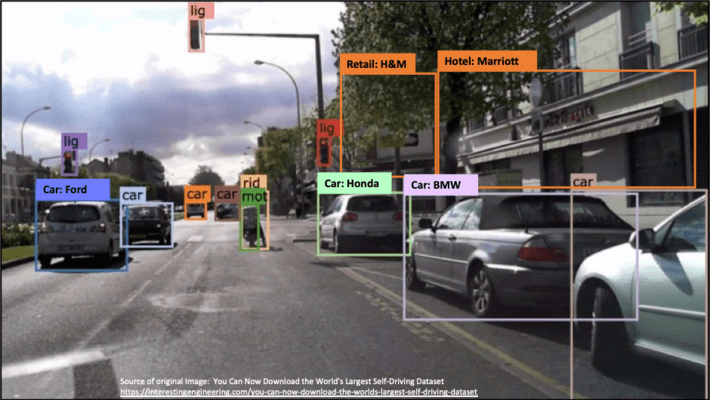
Figure 1: The “Digital Exhaust” from Autonomous Vehicles
Tesla has coupled its insatiable hunger for data with a mastery of AI that enables them to follow their customers into almost any business without being constrained by artificially-defined industry borders.
The mastery of data and AI enable organizations to create agile and adaptive business strategies; business strategies that learn and adapt as fast as customers and markets evolve.
But before jump into how AI can create an agile and adaptive business strategy, let’s review some of the basics of AI.
Developing a Realistic, Not a Science Fiction, AI Strategy
There is little doubt that AI will become the differentiating capability for business survival in the 21st century; that achieving digital transformation will require both a Data Strategy (to fuel Digital Transformation) and an AI Strategy (to create an agile and adaptive business strategy that continuously seeks to derive and drive new sources of value).
What makes AI so powerful?
It’s ability to continuously interact, learn and adapt to its environment…sometimes with minimal human intervention. AI relies upon “AI Agents” that interact with its environment to continuously learn and adapt, where learning is guided by the definition of organization’s AI Utility Function (see Figure 2).
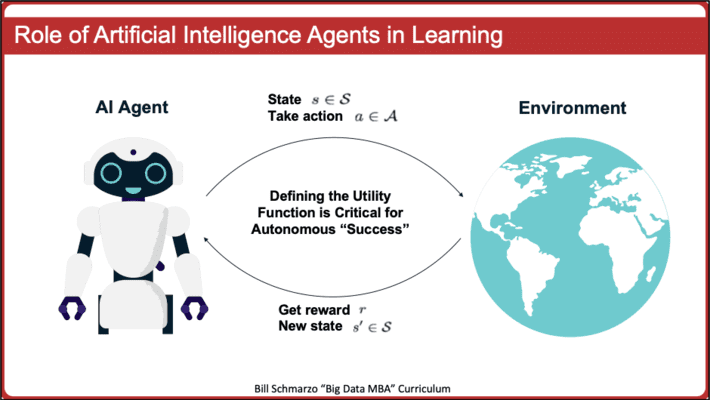
The more the AI Agents interact with their environment, the faster the AI Agents learn about the tendencies, propensities, associations, relationships, preferences and biases of humans and devices that comprise the environment; that is, these AI Agents are continuously updating and refining their actionable insights about the Analytic Assets – the Analytic Profiles and Digital Twins – that comprise the environment (see Figure 3).
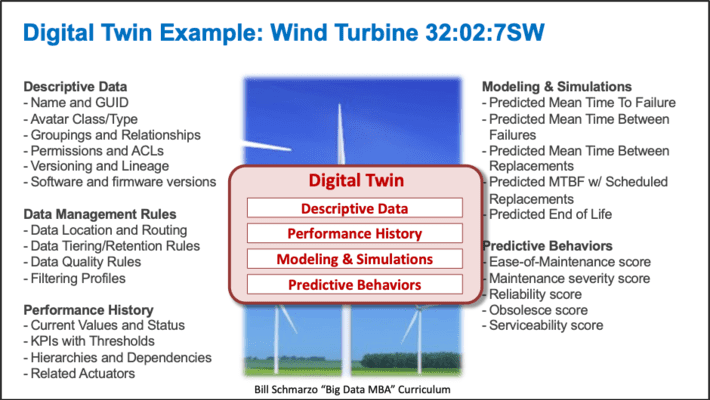
Organizations that want to create agile and adaptive business strategies will need to adopt new operating principles including:
- Principle #1: AI derives and drives customer, product and operational value at the operational front-lines, not in the ivory towers of senior management.
- Principle #2: Operating your business with static TPS-like policies is like wrestling with a Chinese Finger Trap, the harder you fight, the more futile the struggling becomes. Policies will need to embrace AI to become more dynamic and continuously-learning and adapting.
- Principle #3: In order to create a more agile and adaptable strategy, organizations must embrace and commit to the concept that the “Economies of Learning” are more powerful than the “Economies of Scale.”
Principle #1: AI Value is Created at the Front-Lines
Sorry Mahogany Row Executives, but AI just doesn’t find you folks very interesting. It’s not that you aren’t important, but tomorrow’s digital winners will be those organizations that learn and adapt faster to market, economic, social, environmental, and political changes than their competition. And in order to leverage AI to create agile and adaptive business strategies, senior executives must learn to let go, and empower their front-line teams.
In one of my favorite team empowerment lessons, British Admiral Lord Nelson faced the superior forces of the French and Spanish Armada in the 1805 Battle of the Trafalgar. While much credit for Lord Nelson’s stunning victory (biggest upset since Camp North Star beat Camp Mohawk) was given to his innovative battle strategy (as depicted in Figure 4), the key to victory was empowering each ship captain to operate independently. Each captain was trained to “think on their own” during the battle, and Lord Nelson’s decentralized, empowered teams smashed the command-and-control structure of the French and Spanish Armada (see Figure 4).
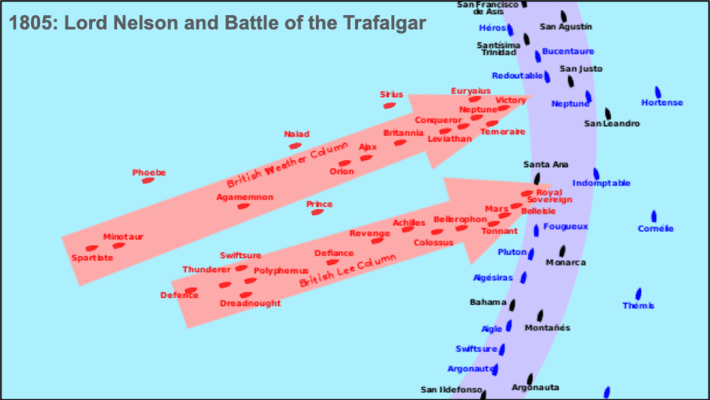
Today’s digital competitor operates in smaller, highly-cohesive teams, exhibits extreme flexibility in the execution of its objectives, learns/unlearns/relearns rapidly and shares a common vision and language. And to successfully compete with these digital competitors, it’ll take empowered teams with a continuously learning and adapting business strategy.
Strategy may trickle down, but with AI, learnings, adaption and value amplify going up!
Principle #2: Policies Must be Able to Learn and Adapt
As I wrote in the blog “Leverage AI to Create Autonomous Policies that Adapt to Human Intervention ”, the creation and management of policies haven’t changed much since the days of “time-and-motion studies”. In many cases, policies are nothing more than a static list of what-if rules that govern what workers are to do in well-defined situations. For example, [If your car has been driven over 3,000 miles since the last oil change, then change the oil] or [If you haven’t visited the dentist in greater than 6 months, then visit the dentist].
But what if these policies instead were AI-based, and learned and adapted to the constantly evolving state of the business…with minimal human intervention? In much the same way that we are seeing AI create autonomous vehicles, robots and devices that learn and adapt without human intervention, can we leverage AI to create autonomous policies that learn and adapt with minimal human intervention (see Figure 5)?
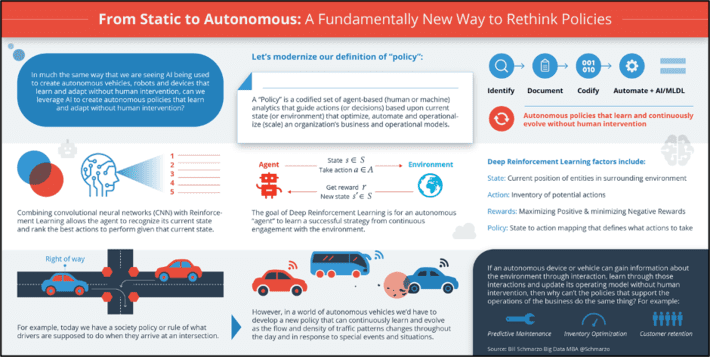
Using AI, we can transition from static policies to autonomous policies that dynamically learn and adapt in response to constantly changing economic, environmental and social conditions. Continuously-learning policies are the foundation for organizations seeking to create learning and adapting business strategies.
Principle #3: Mastering the Economies of Learning
For Digital organizations, “Economies of Learning” are more powerful than “Economies of Scale” because of the ability to learn, adapt and reapply those learnings across multiple use cases. With “Economies of Learning”, analytic assets appreciate, not depreciate, in value the more that they are used; these analytic assets get more accurate, more efficient, more reliable, safer and ultimately, more intelligent (see Figure 6).
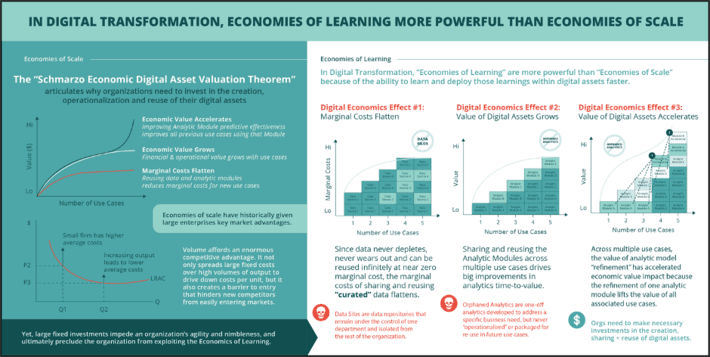
Organizations can exploit the continuously-learning and adapting aspects of AI by deploying AI on a use-case-by-use-case basis in order to reapply data and analytic learnings to the next use cases. The “Thinking Like A Data Scientist” methodology drives organizational alignment in identifying, validating, valuing and prioritizing the use cases that support the organization’s key business initiatives.
If learning is tomorrow’s battleground, AI will be mandatory in accelerating an organization’s ability to learn, adapt and reapply new customer, product and operational learnings across the organization.
Summary: Creating a Learning-based AI Business Strategy
AI – with its ability to continuously learn, adapt and reapply those learnings – will have the biggest business impact on operational decisions. And that learning, adapting and reapplication will happen at the front lines of the organization (see Figure 7).
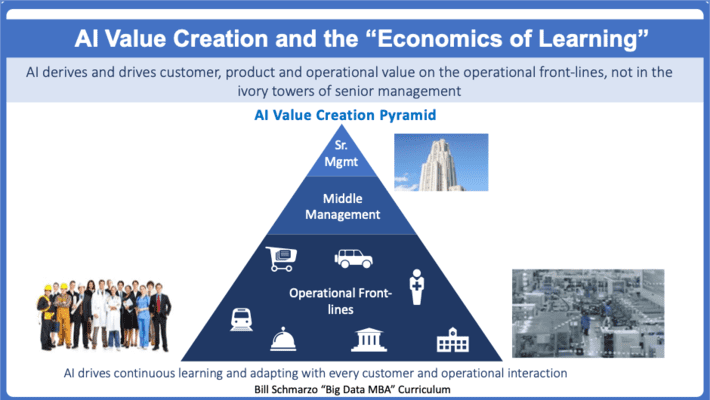
Digitally transforming organizations must exploit the continuous learning and adapting capabilities of AI by empowering their front-line employees; creating operational environments where the business is continuously learning and adapting from every customer engagement and every operational activity, and those learnings are rippling back up the organization to drive a continuously-learning and adapting business strategy.
